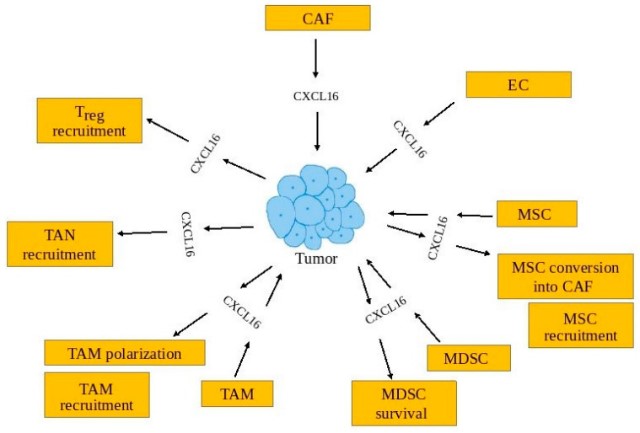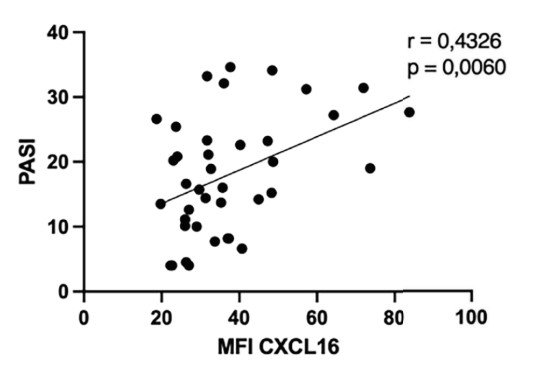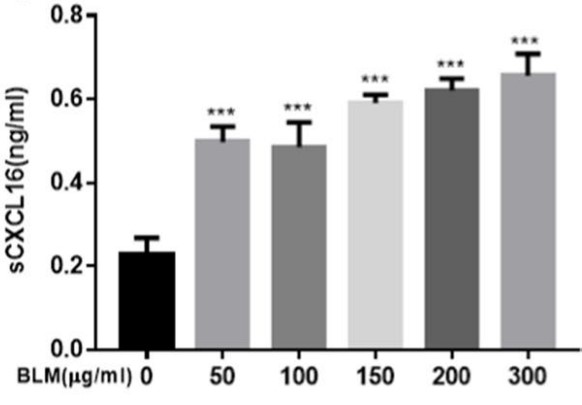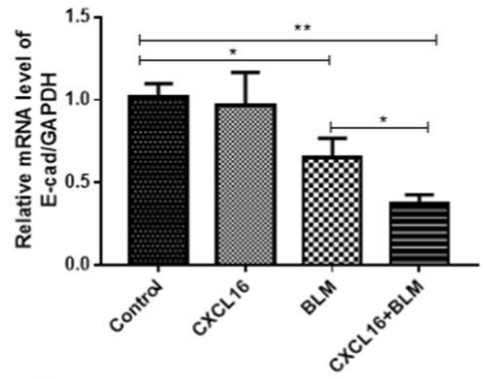Cxcl16
-
Official Full Name
chemokine (C-X-C motif) ligand 16 -
Overview
Chemokine (C-X-C motif) ligand 16 (CXCL16), also known as SR-PSOX, is a transmembrane protein that facilitates uptake of low density lipoproteins by macrophages, resulting in foam cell formation. CXCL16 is found in liver tissue2 and influences the uptake, subcellular localization, and cytokine profile induced by D oligonucleotides. 3 CXCL16 may play a pro- inflammatory role in Inflammatory Bowel Disease (IBD), particularly Crohns disease. -
Synonyms
chemokine (C-X-C motif) ligand 16;SRPSOX;CXCLG16;SR-PSOX;CXCL16;CXC chemokine ligand 16;Scavenger receptor for phosphatidylserine and oxidized low density lipoprotein;Small-inducible cytokine B16;Transmembrane chemokine CXCL16
Recombinant Proteins
- Human
- Mouse
- Monkey
- Rat
- Canine
- Rhesus macaque
- E.coli
- HEK293
- Mammalian Cells
- Human Cells
- In Vitro Cell Free System
- Yeast
- GST
- His
- Fc
- T7
- Non
- SUMO
- Avi
Background
What is CXCL16 protein?
CXCL16 (C-X-C motif chemokine ligand 16) gene is a protein coding gene which situated on the short arm of chromosome 17 at locus 17p13. CXCL16 is a small molecule chemokine that belongs to the C-X-C chemokine family, members of which play important roles in cell development, inflammation and immune response. CXCL16 protein has multiple domains, including chemokine domain, mucin-like stem domain, single transmembrane domain, and cytoplasmic tail domain. This unique structure allows it to function both as an adhesion molecule on the cell surface and as a soluble chemokine. The CXCL16 protein is consisted of 254 amino acids and its molecular mass is approximately 27.6 kDa.
What is the function of CXCL16 protein?
CXCL16, by binding to its specific receptor CXCR6, mediates the migration of a variety of immune cells, including T cells, NK cells and macrophages. CXCL16 plays an important role in a variety of biological processes, including inducing immune cell migration to infection or inflammation sites and thus participating in host defense responses; During the inflammatory process, the expression level of CXCL16 increases, and it participates in the regulation of inflammatory response by attracting immune cells. CXCL16 also plays a role in the development of certain cancers, where it can promote the invasion of tumor-associated macrophages and is associated with tumor aggressiveness and prognosis.
CXCL16 Related Signaling Pathway
CXCL16 activates the NF-κB pathway, which influences inflammation and immune responses. CXCL16 can affect cell proliferation and survival through JAK-STAT pathway. CXCL16 can activate the PI3K/AKT pathway, thereby affecting cell survival and migration. CXCL16 can activate the mitogen activated protein kinase (MAPK) pathway, thereby affecting cell proliferation, differentiation and survival. VEGFR/VEGF signaling pathway: CXCL16 is also involved in angiogenesis, as it can activate the VEGFR/VEGF pathway and promote the formation of new blood vessels. In some cases, CXCL16 can also activate the Notch signaling pathway, which in turn affects cell fate decisions. CXCL16 can also influence cell survival and migration in hypoxic environments through the HIF-1α signaling pathway.
CXCL16 Related Diseases
CXCL16 expression is increased in a variety of cancers, including breast cancer, lung cancer, and melanoma. It is involved in tumor growth, metastasis and angiogenesis. CXCL16 has been implicated in atherosclerosis and cardiovascular disease, possibly by influencing angiogenesis and inflammatory responses. CXCL16 is expressed in a variety of autoimmune diseases, including rheumatoid arthritis and systemic lupus erythematosus. Other diseases include viral infections, kidney diseases, neurological disorders, etc.

Fig1. In the tumor, CXCL16-mediated intercellular communication creates multiple relationships between various cells. (Jan Korbecki, 2021)
Bioapplications of CXCL16
Because of its role in a variety of diseases, CXCL16 could be a potential target for new drug development. Research into inhibitors or antagonists of CXCL16 may help treat related diseases. CXCL16's role in regulating immune cell function makes it a strong candidate for the development of immunotherapies against cancer and other immune-related diseases.
Case Study
Case Study 1: Lisa Schielke, 2022
Psoriasis is frequently associated with the metabolic syndrome and occurs more often in obese individuals. In order to understand innate immune mechanisms mediating this inflammatory pattern the researchers investigated expression of the chemokine and lipid scavenger receptor CXCL16 in patients with psoriasis and associated comorbidities. CXCL16 expression was enhanced on all monocyte subsets in psoriatic patients compared with healthy controls. The intensity of CXCL16 expression on monocytes further correlated with their capability to phagocytose oxidized LDL indicating the possibility to transform into foam cells in atherosclerotic plaques. The expression of the CXCL16 receptor, CXCR6, was increased in ILCs and co-expressed with CCR6 but not CCR7 indicating their migratory potential to psoriatic skin or adipose tissue that is characterized by strong CXCL16 and CCL20 expression. This hypothesis was supported by the finding that the percentage of CXCR6 expressing ILCs was alleviated in blood of psoriatic patients.

Fig1. Correlation of CXCL16 expression on all monocytes of psoriatic patients (n=39) and clinical disease activity (PASI), Pearson's correlation.
 of CXCL16 and oxLDL is shown.jpg)
Fig2. The mean fluorescence intensity (MFI) of CXCL16 and oxLDL is shown.
Case Study 2: Zhenzhen Ma, 2021
Alveolar epithelial cells play an essential role in the initiation and progression of pulmonary fibrosis, and the occurrence of epithelial-mesenchymal transition (EMT) may be the early events of pulmonary fibrosis. Recent studies have shown chemokines are involved in the complex process of EMT, and CXC chemokine ligand 16 (CXCL16) is also associated with many fibrosis-related diseases. However, whether CXCL16 is dysregulated in alveolar epithelial cells and the role of CXCL16 in modulating EMT in pulmonary fibrosis has not been reported. This study found that CXCL16 and its receptor C-X-C motif chemokine receptor 6 (CXCR6) were upregulated in bleomycin induced EMT in human alveolar type II-like epithelial A549 cells. Synergistic effect of CXCL16 and bleomycin in promoting EMT occurrence, extracellular matrix (ECM) excretion, as well as the pro-inflammatory and pro-fibrotic cytokines productions in A549 cells were observed, and those biological functions were impaired by CXCL16 siRNA. CXCL16 was further confirmed to regulate EMT in A549 cells via the TGF-β1/Smad3 pathways.

Fig3. The expression of sCXCL16 in the cell culture supernatant was detected by ELISA.

Fig4. After co-stimulation of CXCL16 (200 ng/ml) and BLM (200 μg/ml) in A549 cells for 24 h, the mRNA levels of E-cad.
Quality Guarantee
High Purity
.jpg)
Fig1. SDS-PAGE (CXCL16-7648H)
.
.jpg)
Fig2. SDS-PAGE (CXCL16-881H)
Involved Pathway
Cxcl16 involved in several pathways and played different roles in them. We selected most pathways Cxcl16 participated on our site, such as Cytokine-cytokine receptor interaction,Chemokine signaling pathway, which may be useful for your reference. Also, other proteins which involved in the same pathway with Cxcl16 were listed below. Creative BioMart supplied nearly all the proteins listed, you can search them on our site.
| Pathway Name | Pathway Related Protein |
|---|---|
| Chemokine signaling pathway | ROCK1,PF4V1,CCL18,GNAI2,GNG5,GRB2,GNB1,CCL15,CCL6,CCL4L2 |
| Cytokine-cytokine receptor interaction | IFNAR2,PRL,CCL6,CXCL3,IL13RA1,CCL22,TGFBR1,LOC100033925,GM-CSF,IL-8 |
Protein Function
Cxcl16 has several biochemical functions, for example, chemokine activity,low-density lipoprotein receptor activity,scavenger receptor activity. Some of the functions are cooperated with other proteins, some of the functions could acted by Cxcl16 itself. We selected most functions Cxcl16 had, and list some proteins which have the same functions with Cxcl16. You can find most of the proteins on our site.
| Function | Related Protein |
|---|---|
| scavenger receptor activity | DMBT1,TMPRSS4A,CD163L1,LGALS3BPB,POLR1B,PRG4A,LOXL3A,LOXL2,ACKR4,LGALS3BPA |
| chemokine activity | CCL16,CCL39.1,CXCL9,CXCL14,CCL19B,CCL38A.4,CCL38A.5,XCL1,CXL34B.11,CCL2 |
| low-density lipoprotein receptor activity | LDLR,LRP6,OLR1,LRP12,VLDLR |
Interacting Protein
Cxcl16 has direct interactions with proteins and molecules. Those interactions were detected by several methods such as yeast two hybrid, co-IP, pull-down and so on. We selected proteins and molecules interacted with Cxcl16 here. Most of them are supplied by our site. Hope this information will be useful for your research of Cxcl16.
Resources
Gene Families
Research Area
Related Services
Related Products
References
- Wehr, A; Baeck, C; et al. Pharmacological Inhibition of the Chemokine CXCL16 Diminishes Liver Macrophage Infiltration and Steatohepatitis in Chronic Hepatic Injury. PLOS ONE 9:-(2014).
- Wang, L; Sun, SZ; et al. oxLDL-Induced Lipid Accumulation in Glomerular Podocytes: Role of IFN-gamma, CXCL16, and ADAM10. CELL BIOCHEMISTRY AND BIOPHYSICS 70:529-538(2014).



